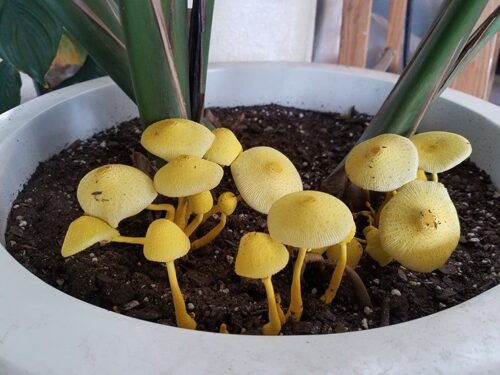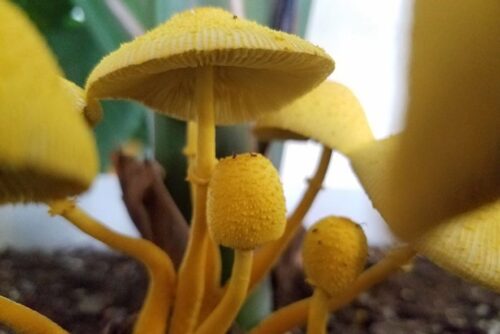If mushrooms grow in your plant, remove them immediately to prevent harm to your plant’s health and promote proper growth. Mushrooms can indicate underlying issues such as over-watering or poor drainage, so adjusting these factors may be necessary.
Additionally, improve air circulation and sunlight exposure to discourage mushroom growth. Make sure to monitor your plant regularly and address any further fungal growth promptly. Taking these steps will help maintain the health and vitality of your plants.

Credit: www.thesill.com
Identifying The Problem
Identifying the Problem: Discovering mushrooms growing in your plant can be alarming, but understanding the problem is the first step to addressing it effectively.
Recognizing The Signs
Look for:
- Unexpected growth in soil
- Mushrooms with distinct caps
- Foul smell or mold around the plant
Determining The Type Of Mushroom
Steps to Identify:
- Observe the shape and color of the mushrooms
- Check for any gills or pores underneath the cap
- Research common types of mushrooms found in plants

Credit: www.patchplants.com
Removing Mushrooms
If you find mushrooms growing in your plant, it is important to take action as soon as possible. Leaving the mushrooms unattended can harm your plant and may even indicate an underlying issue with the growing conditions. In this section, we will discuss two effective methods for removing mushrooms from your plant: manual removal and changing growing conditions.
Manual Removal
To manually remove mushrooms from your plant, follow these simple steps:
- Put on a pair of gloves to protect your hands from any potential irritants.
- Using your fingers, gently grasp the base of the mushroom and carefully pull it out.
- Avoid breaking the stem or releasing spores, as this can encourage further mushroom growth.
- Place the removed mushrooms in a bag and dispose of them properly.
- Inspect the area around the plant for any remaining mushrooms and repeat the removal process if necessary.
By manually removing the mushrooms, you eliminate their presence and prevent them from spreading further.
Changing Growing Conditions
Addressing the growing conditions of your plant is crucial to prevent mushrooms from reappearing. Consider the following measures:
- Reduce moisture: Mushrooms thrive in damp environments, so ensure that your plant is not overwatered.
- Improve air circulation: Proper airflow around the plant will help reduce humidity and discourage mushroom growth.
- Modify temperature: Some mushrooms prefer cooler temperatures, so adjusting the temperature may help inhibit their growth.
- Use well-draining soil: Fungal growth can be minimized by using soil that drains well and promotes good root health.
By implementing these changes, you create an unfavorable environment for mushrooms to grow in your plant.
Preventing Future Growth
If you’ve had an unwelcome surprise of mushrooms growing in your plant, you definitely want to take measures to prevent their future growth. Mushrooms are indicators of an unhealthy environment for your plants, as they typically thrive in damp and poorly ventilated conditions. By improving air circulation and adjusting your watering practices, you can create an environment where mushrooms are less likely to take root.
Improving Air Circulation
Good air circulation around your plants can help prevent the growth of mushrooms. Here are a few simple ways to improve air circulation:
- Space out your plants to allow for adequate airflow between them.
- Trim any overgrown branches or foliage that may be blocking airflow.
- Consider using a fan to increase air movement near your plants.
- Keep your plants away from walls or other objects that can restrict air circulation.
By implementing these measures, you can ensure that your plant’s environment remains breathable and less favorable for mushroom growth.
Adjusting Watering Practices
Proper watering is essential for plant health, and this includes preventing mushrooms from thriving. Here are some tips for adjusting your watering practices:
- Water your plants in the morning to allow excess moisture to evaporate during the day.
- Avoid overwatering your plants, as this can create a stale and moist environment.
- Ensure proper drainage by using well-draining soil and pots with drainage holes.
- Consider using a moisture meter to determine when your plants actually need watering.
By adjusting your watering practices and avoiding conditions that promote excessive moisture, you can help reduce the chances of mushrooms growing in your plant.

Credit: www.thesill.com
Evaluating Plant Health
Understanding the health of your plant is crucial when mushrooms grow in your plant. Proper evaluation of your plant’s health will help you address the issue effectively and prevent further complications.
Assessing Root Health
Check the roots for signs of rotting, such as dark, mushy roots. Healthy roots are firm and white.
Monitoring For Continued Growth
Observe if the mushrooms continue to grow. Continued growth may indicate underlying issues that need to be addressed.
Seeking Professional Help
If you notice mushrooms growing in your plant, seeking professional help is crucial to ensure the health of your plant and to address any underlying issues. Here are some steps you can take to get the expert assistance you need:
Consulting A Garden Expert
1. Look for a reputable garden expert in your area with experience in dealing with plant fungi and diseases.
2. Schedule a consultation to have the expert assess the situation and provide recommendations for addressing the mushroom growth in your plant.
Contacting Plant Disease Specialist
1. Research and reach out to a plant disease specialist who can offer specific expertise in identifying and treating fungal issues in plants.
2. Seek their advice on how to effectively eliminate the mushrooms from your plant and prevent future occurrences.
Frequently Asked Questions Of What To Do If Mushrooms Grow In Your Plant?
Should I Let Mushrooms Grow In My Plants?
Yes, letting mushrooms grow in your plants can be harmful to them. Mushrooms can compete with plants for nutrients and water, leading to poor growth. Additionally, some mushrooms may be toxic to humans and pets if ingested. It’s best to remove them promptly.
How Do I Get Rid Of Mushrooms In My Potted Plants?
To remove mushrooms from potted plants, increase airflow, avoid overwatering, and replace the top layer of soil.
Why Did A Mushroom Grow In My Potted Plant?
Mushrooms grow in potted plants due to excess moisture and organic matter in the soil. Provide proper drainage and avoid overwatering to prevent their growth.
Can You Eat Mushrooms That Grow In Your Plants?
Yes, you can eat mushrooms that grow in your plants as long as you can positively identify them as safe and edible varieties. Ensure you have proper knowledge to differentiate between edible and poisonous mushrooms before consuming them.
Conclusion
If you discover mushrooms in your plant, removing them promptly is essential. Implementing proper watering and sunlight practices can prevent their return. Stay vigilant and address any excess moisture issues to maintain a healthy environment for your plants. Regularly monitor and care for your plants to prevent future mushroom growth.
